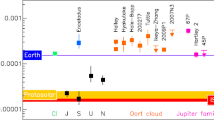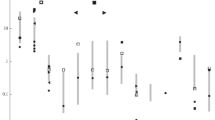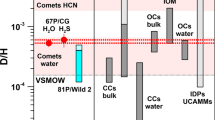Abstract
Deuterium fractionations in cometary ices provide important clues to the origin and evolution of comets. Mass spectrometers aboard spaceprobe Giotto revealed the first accurate D/H ratios in the water of Comet 1P/Halley. Ground-based observations of HDO in Comets C/1996 B2 (Hyakutake) and C/1995 01 (Hale-Bopp), the detection of DCN in Comet Hale-Bopp, and upper limits for several other D-bearing molecules complement our limited sample of D/H measurements. On the basis of this data set all Oort cloud comets seem to exhibit a similar (D/H)H2O ratio in H2O, enriched by about a factor of two relative to terrestrial water and approximately one order of magnitude relative to the protosolar value. Oort cloud comets, and by inference also classical short-period comets derived from the Kuiper Belt cannot be the only source for the Earth’s oceans. The cometary 0/C ratio and dynamical reasons make it difficult to defend an early influx of icy planetesimals from the Jupiter zone to the early Earth. D/H measurements of OH groups in phyllosilicate rich meteorites suggest a mixture of cometary water and water adsorbed from the nebula by the rocky grains that formed the bulk of the Earth may be responsible for the terrestrial D/H. The D/H ratio in cometary HCN is 7 times higher than the value in cometary H2O. Species-dependent D-fractionations occur at low temperatures and low gas densities via ion-molecule or grain-surface reactions and cannot be explained by a pure solar nebula chemistry. It is plausible that cometary volatiles preserved the interstellar D fractionation. The observed D abundances set a lower limit to the formation temperature of (30 ± 10) K. Similar numbers can be derived from the ortho-to-para ratio in cometary water, from the absence of neon in cometary ices and the presence of S2. Noble gases on Earth and Mars, and the relative abundance of cometary hydrocarbons place the comet formation temperature near 50 K. So far all cometary D/H measurements refer to bulk compositions, and it is conceivable that significant departures from the mean value could occur at the grain-size level. Strong isotope effects as a result of coma chemistry can be excluded for molecules H2O and HCN. A comparison of the cometary (D/H)H2O ratio with values found in the atmospheres of the outer planets is consistent with the long-held idea that the gas planets formed around icy cores with a high cometary D/H ratio and subsequently accumulated significant amounts of H2 from the solar nebula with a low protosolar D/H.
Access this chapter
Tax calculation will be finalised at checkout
Purchases are for personal use only
Preview
Unable to display preview. Download preview PDF.
Similar content being viewed by others
References
A’hearn, M.F., and Feldman, P.D.: 1985, In Ices in the Solar System (Klinger, J., Benest, D., and Smoluchowski, R., Eds.), pp. 463–471, D. Reidel Publishing Company, Dordrecht (USA).
A’hearn, M.F., Schleicher, D.G., and West, R.A.: 1985, Astrophys. J. 297, 826–836.
Aikawa, Y., Umebayashi, T., Nakano, T., and Miyama, S.M.: 1997. Astrophys. J. Lett. 486, L51–L54.
Balsiger, H., Altwegg, K., and Geiss, J.: 1995, J. Geophys. Res. 100, 5827–5834.
Bockelée-Morvan, D., Gautier, D., Lis, D.C., Young, K., Keene, J., Phillips, T., Owen, T., Crovisier, J., Goldsmith, P.F., Bergin, E.A., Despois, D., and Wootten, A.: 1998, Icarus 133, 147–162.
Brown, P.D., and Millar, T.J.: 1989, Mon. Not. R. Astron. Soc. 237, 661–671.
Coustenis, A., Salama, A., Lellouch, E., Encrenaz, Th., de Graaw, Th., Bjoraker, G.L., Samuelson, R.E., Gautier, D., Feuchgruber, H., Kessler, M.F., and Orton, G.S.: 1998, Bul. Am. Astron. Soc. 30, 1060.
Crovisier, J., Bockelée-Morvan, D., Colom, P., Despois, D., and Paubert, G.: 1993, Astron. Astrophys. 269, 527–540.
Crovisier, J., Leech, K., Bockelée-Morvan, D., Brooke, T.Y., Hanner, M.S., Altieri, B., Keller, H.U., and Lellouche, E.: 1997, Science 275, 1904–1907.
Crovisier, J.: 1998, Bul. Am. Astron. Soc. 30, 1059–1060.
Delsemme, A.H.: 1998, Planet Space Sci., in press.
Deloule, E., Doukhan, J.-P., and Robert, F.: 1997, Proc. Lunar Planet. Sci. Conf. 28th, 291-292.
Duncan, M., Quinn, T., and Tremarne S.: 1987, Astron. J. 94, 1330–1338.
Eberhardt, P., Meier, R., Krankowsky, D., and Hodges, R.R.: 1994, Astron. Astrophys. 288, 315–329.
Eberhardt P., Reber, M., Krankowsky, D., and Hodges, R.R.: 1995, Astron. Astrophys. 302, 301–316.
Eberhardt, P.: 1999, In Proc. IAU Colloq. 168, Cometary Nuclei in Space and Time (A’hearn, M.F., Ed.), Astron. Soc. Pacific Conf. Ser., in press.
Epstein, R.I., Lattimer, J.M., and Schramm, D.N.: 1976, Nature 263, 198–202.
Fegley, B., Jr., and Prinn, R.G.: 1989, In The formation and evolution of planetary systems (Weaver, H.A., and Danly, L., Eds.), pp. 171–211, Cambridge U. Press, Cambridge (UK).
Feuchtgruber, H., Lellouch, E., Bézard, B., Encrenaz, Th., de Graaw, Th., and Davis, G.R.: 1999, Astron. Astrophys. 341, L17–L21.
Gautier D. and Morel, P.: 1997, Astron. Astrophys. 323, L9–L12.
Gautier, D.: 1999, In Planetary systems: The long view (Celnikier, L., Ed.), in press, Blois (France).
Geiss, J., and Reeves, H.: 1981, Astron. Astrophys. 93, 189–199.
Geiss, J.: 1993, In Origin and evolution of the elements (Prantzos, N., Vangioni-Flam, E., and Cassé, M., Eds.), pp. 87–106, Cambridge Univ. Press, Cambridge (UK).
Greenberg, M., and Li, A.: 1999, Space Sci. Rev., this volume.
Griffith, C.A., and Zahnle, K.: 1995, J. Geophys. Res. 100, 16, 907–916, 922.
Griffin, M.J., et al.: 1996, Astron. Astrophys. 315, L389–L392.
Grinspoon, D.H. and Lewis J.S.: 1988, Icarus 72, 430–436.
Hubbard, W.B., and MacFarlane, J.J.: 1980, Icarus 127, 307–318.
Hubbard, W.B., Podolak, M., and Stevenson, D.J.: 1995, In Neptune and Triton (Cruikshank, D.P., Ed.), pp. 109–140, U. of Arizona Press, Tucson (USA).
Irvine, W.M., Bergin, E.A., Dickens, J.E., Jewitt, D., Lovell, A.J., Matthews, H.E., Schloerb, F.P., and Senay, M.: 1998, Nature 393, 547–550.
Jessberger, E.: 1999, Space Sci. Rev., this volume.
Klinger, J., Eich, G., Bischoff, A., Joó, F., Kochan, H., Roessler, K., Stichler, W., and Stöeffler, D.: 1989, Adv. Space Res. 9(3), 123–125.
Krasnopolsky, V.A., Mumma, M.J., Abbott, M., Flynn, B.C., Meech, K.J., Yeomans, D.K., Feldman, P.D., and Cosmovici, C.B.: 1997, Science 277, 1488–1491.
Lécluse, C., and Robert, F.: 1994, Geochim. Cosmochim. Acta 58, 2927–2939.
Lunine, J.I., Engle, S., Riszk, B., and Horanyi, M.: 1991, Icarus 94, 333–344.
Mahaffy, P.R., Donahue, T.M., Atreya, S.K., Owen, T.C., and Niemann, H.B.: 1998. Space Sci. Rev. 84, 251–263.
Meier, R., Owen, T.C., Matthews, H.E., Jewitt, D.C., Bockelée-Morvan, D., Biver, N., Crovisier, J., and Gautier, D.: 1998a, Science 279, 842–844.
Meier, R., Owen, T.C., Jewitt, D.C., Matthews, H.E., Senay, M., Biver, N., Bockelée-Morvan, D., Crovisier, J., and Gautier, D.: 1998b, Science 279, 1707–1710.
Meier, R., Wellnitz, D., Kim, S.J., and A’hearn, M.F.: 1998c, Icarus 136, 268–279.
Millar, T.J., Bennett, A., and Herbst, E.: 1989, Astrophys. J. 340, 906–920.
Mumma, M.J., Weissman, P.R., and Stern, S.A.: 1993, In Protostars and planets III, (Levy, E.H., and Lunine, J.I., Eds.), pp. 1177–1252, U. of Arizona Press, Tucson (USA).
Mumma, M.J., DiSanti, M.A., Dello Russo, N., Fomenkova, M., Magee-Sauer, K, Kaminski, C.D., and Xie, D.X.: 1996, Science 272, 1310–1314.
Notesco, G., Laufen, G., and Bar-Nun, A.: 1997, Icarus 125, 471–473.
Owen, T.C., and Bar-Nun, A.: 1995, Icarus 116, 215–226.
Owen, T.C.: 1997, In From Stardust to planetesimals (Pendleton, Y.J., and Tielens, A.G.G.M., Eds.), pp. 435–450, Astron. Sci. Pacific Public. 122, San Francisco (USA).
Podolak, M., Weizman, A., and Marley, M.: 1995, Planet. Space Sci. 43, 1517–1522.
Pringle, J.E.: 1981, Ann. Rev. Astron. Astrophys. 19, 137–162.
Schleicher, D.G., and A’hearn, M.F.: 1986, In New insights in astrophysics. Eight years of UV astronomy with WE (Rolfe, E.J., Ed.), pp. 31-33, ESA SP-263, ESA, Paris (France).
Wagoner, R.V., Fowler, W.A., and Hoyle, F.: 1967, Astrophys. J. 148, 3–49.
Willacy, K., Klahr, H.H., Millar, T.J., and Henning, Th.: 1998, Astron. Astrophys. 338, 995–1005.
Williams, T.L., Adams, N.G., Lucia, M.B., Herd, Ch.R., and Geoghegan, M.: 1996. Mon. Not. R. Astron. Soc. 282, 413–420.
Author information
Authors and Affiliations
Editor information
Editors and Affiliations
Rights and permissions
Copyright information
© 1999 Springer Science+Business Media Dordrecht
About this paper
Cite this paper
Meier, R., Owen, T.C. (1999). Cometary Deuterium. In: Altwegg, K., Ehrenfreund, P., Geiss, J., Huebner, W.F. (eds) Composition and Origin of Cometary Materials. Space Science Series of ISSI, vol 8. Springer, Dordrecht. https://doi.org/10.1007/978-94-011-4211-3_3
Download citation
DOI: https://doi.org/10.1007/978-94-011-4211-3_3
Publisher Name: Springer, Dordrecht
Print ISBN: 978-94-010-5830-8
Online ISBN: 978-94-011-4211-3
eBook Packages: Springer Book Archive




